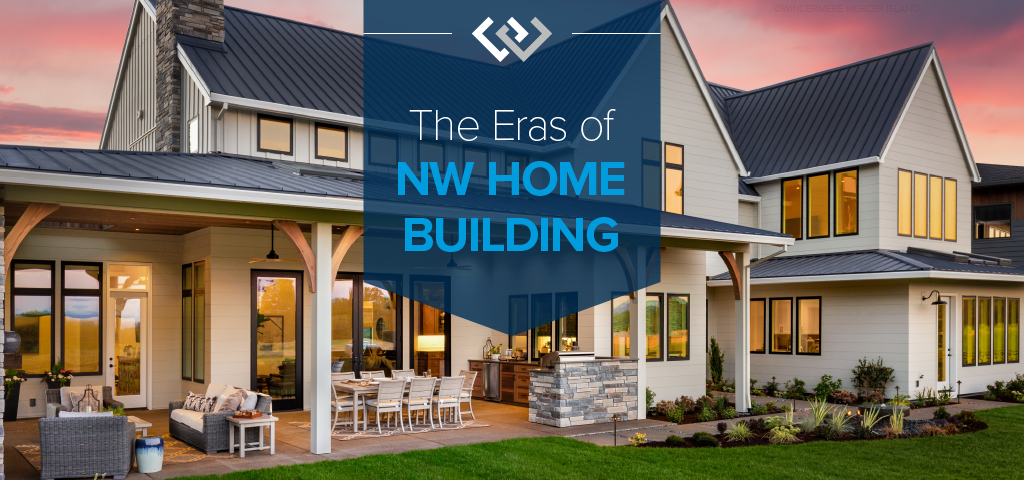The Northwest has experienced many changes in residential construction though the eras of home building. While not universal, here are a few typical housing rules of thumb we have seen in the Seattle region…
Styles, floor plans and typical home attributes:
1900-1920’s
Craftsman, Arts & Crafts, and Tudor homes dominated this era. They often featured more built-in cabinets and custom woodwork. Most were two stories (with or without a basement), and had smaller, functional rooms with an overall feel of quality and charm. Smaller, detached, alley-accessed garages were common.
1930-1940’s
Post-War Box Houses were typical of this depression and wartime era. Often very small and economically constructed, they had fewer windows, were most likely one-level homes or basement ramblers with only one bathroom, and rarely had a garage.
1950-1960’s
Mid-Century Modern homes inspired by post-war exuberance brought us the solidly built homes of this era, which remain extremely popular today for their design, floor-plan flow, and significant use of windows that invite in the natural light. Modern lines, larger and flowing rooms, flatter rooflines, and smaller kitchens were typical of his era. Larger lots were the norm and carports were more typical than garages.
1970-1980’s
Mid-Entry or Split-Level and NW Contemporary homes brought an entirely different vibe altogether. Affordable building was the buzzword as interest rates hovered at their highest levels in trackable history. Often square footage was split at the entrance by an upper and lower stairwell. Eclectic designs were simple and functional with very separated floor plans and spaces, smaller kitchens, and significant use of stairs. Basements were less common and attached garages became the norm.
1990-2000’s
NW Contemporary and Traditional subdivision homes, inspired by the Growth Management Act of 1990, brought smaller lot sizes to the overall region. The NW Contemporary transitioned into styles that were easily replicated en masse with three car garages, additional rooms, and more bathrooms tucked into a tighter and more efficient package. Traditional home styles emulating earlier 20th century Craftsman and Tudor designs made a comeback with more open floor plans, larger bedrooms, kitchens and family rooms. Formal living and dining rooms began to fade and be replaced with larger universal spaces.
2010-present
Ultra-Modern homes, often with boxy structures and statement or flat roof lines dominate the homebuilding scene. Open floor plans, significant use of windows, very small lot sizes, extreme energy efficiency and smart home technology have become the norm.
Major milestones in home building standards:
Washington’s first energy code, adopted in 1977, was a voluntary requirement, and as such was not well adopted by local home builders. The first statewide energy code applicable to all new buildings came to be in 1986.
Good – Significant improvements in the energy efficiency of homes didn’t occur until 1990, when the Revised Code of Washington required energy-related building standards and increased the insulation requirements for residential buildings. The State Ventilation and Indoor Air Quality Code was also established at that time. The code was amended in 2001 to include increased envelope insulation requirements for residential buildings.
Better – The Washington State Energy Code was made effective July 1, 2007, setting even higher energy efficiency standards for residential construction.
Best – The energy code was updated again in 2015 and is contained in the state of Washington Administrative Code (WAC), (Chapter 51-11).
See the International Code Council for Washington State, the WSU Energy Program, International Building, Fire, Residential and Mechanical Codes, and the Uniform Plumbing Code for more information.
Good years and more cautious years in building:
A good rule of thumb to keep in mind is that homes built during economic downturns (when times are tight) or significant booms (when builders build as fast as they can to meet demand) are often lower quality than homes built when the economy and demand are more stable.
That said, not all homes built in the same era are equal. Some builders deliver solid quality regardless of the cycle while others jump in only when they can turn a quick profit. See below on how to investigate builders.
Every homebuilding era has its upside and its challenges. A good home inspector can evaluate any specific home to determine what deficiencies exist. Here are a few era-based issues we see come up again and again:
Pre 1950 – knob & tube wiring, post & pillar foundations, inferior sewer piping (especially 1940’s), asbestos, lead-based paint
1950’s & 60’s – asbestos, inferior sewer piping, lead-based paint
1970’s – aluminum wiring
1980’s & 90’s – polybutylene/ABS plastic piping, horizontal furnaces/NOX rod heat exchangers, oriented-strand board (OSB) siding failure, exterior insulation and finish system (EIFS) failure
2000 & beyond – mold caused by improper ventilation in extremely efficient homes
Not all homes built (or remodeled) in the same era are equal…
In any market, there are entry-level builders, mainstream builders and high-end builders. Some builders even offer products that span the quality spectrum. Most of the time, these homes remain at that quality level through the years unless a major remodel or significant re-build occurs. As a home buyer, it is important that you evaluate the quality of each home so that you are comparing apples to apples and not giving equal weight to homes of different qualities.
Careful evaluation of a home’s components can help you with this process, as can a qualified inspector. It also helps to check out a builder’s history. This applies whether you are looking at newer construction or something decades old. Start by Googling the builder. Your real estate broker can identify them through the chain of ownership on the tax record.
In addition, home renovations may add another layer of complexity as you’ll not only consider the era of both the original construction and the remodel, but also the quality of the builder/contractor work in each.
Homes that are “flipped,” or renovated to sell, have their own special category. This is because the renovator’s primary goal is to create the most profit, which is directly at odds with renovating for the highest quality (something you would typically see when a homeowner remodels a home for their own use). One inspector put it succinctly: “I’ve inspected thousands of homes and I can count on two hands the flips that have been very well done.” It is more critical than ever to have a flipped home inspected thoroughly to ensure that no corners were cut in the process of giving the home a beautiful new veneer.
Homes that have previously been foreclosed on or were not owner-occupied (rentals) for many years also deserve careful evaluation for signs of deferred maintenance. They might have been maintained perfectly, but it never hurts to be extra careful.
In addition to Googling a home, neighborhood, and/or builder, you can check the history of any builder/remodeler on the State’s L&I Contractor database. The National Association of Home Builders and our local Master Builders Association also offer great resources to help you with your process.
Here are a few more great online resources to add to your knowledge base:
https://sdinspect.com/insiders-guide/
https://www.zillow.com/research/housing-stock-age-8148/
https://www.historylink.org/File/9116
Of course, nothing tops having an experienced pro to guide you through the process. They’ve seen hundreds upon hundreds of homes and can help you identify the solid finds from the duds hiding beneath a gorgeous veneer.
Choosing the right broker can save you thousands on your home purchase. Whether through local market knowledge and pricing analysis allowing you to make a smarter offer, recommendations and resources to thoroughly conduct your due diligence and avoid costly mistakes, or savvy contract negotiation to help you get the terms you need, having a Windermere broker on your side is an advantage you can’t afford to sacrifice.
Find a Home | Sell Your Home | Property Research | Neighborhoods | Market Reports | Our Team
We earn the trust and loyalty of our brokers and clients by doing real estate exceptionally well. The leader in our market, we deliver client-focused service in an authentic, collaborative and transparent manner and with the unmatched knowledge and expertise that comes from decades of experience.
© Copyright 2019 Windermere Mercer Island.

 Facebook
Facebook
 X
X
 Pinterest
Pinterest
 Copy Link
Copy Link


